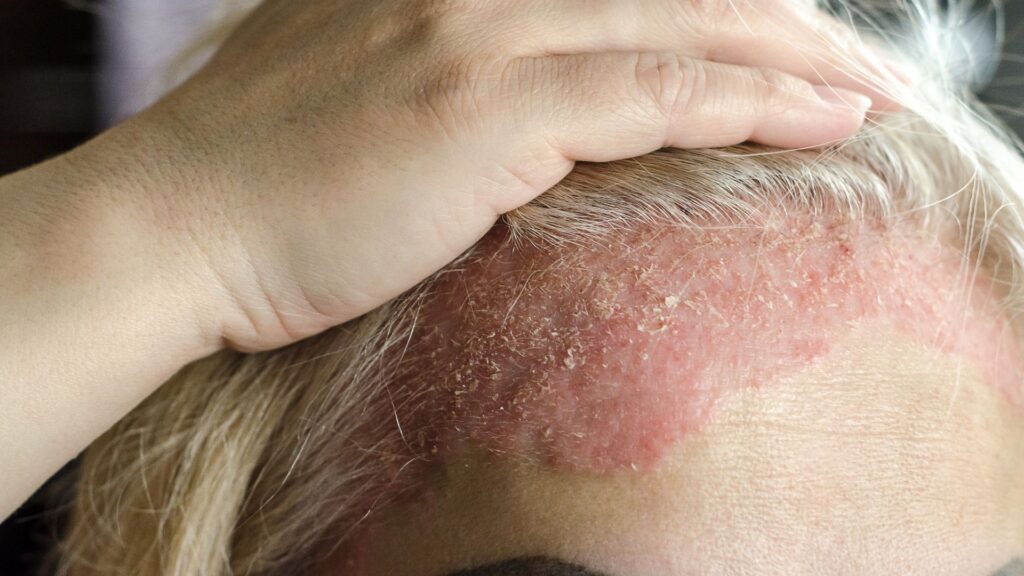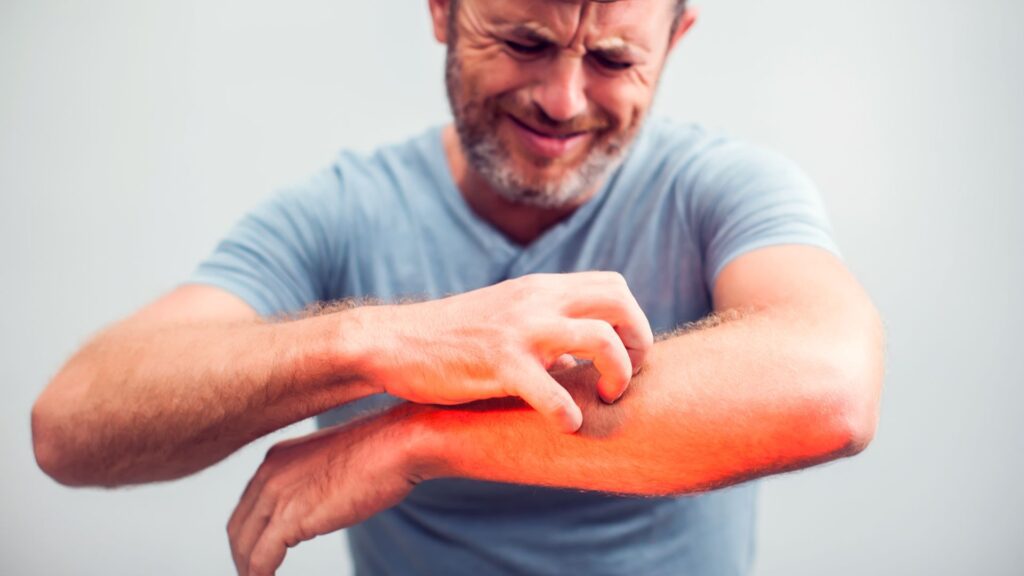Every person has to face the skin problems in winter season. In winter, the skin becomes prone to various diseases due to the lack of moisture in the body due to the dry air, due to which the skin feels dry and irritated. Itches and itches.
The experiences of people who suffer from winter rashes vary. Cold air in winter absorbs moisture from the skin and these skin problems can be avoided by adopting some healthy habits.
Causes of Acne Breakouts in Winter
Dehydration causes excess oil on the skin, which leads to clogged skin pores that lead to dead cells and bacteria. Dry skin can cause pimples and acne on any part of the body.
It mostly occurs on the neck, face, chest, shoulders, waist and arms. Especially touching the face with hands can increase acne breakouts.

Eczema
Eczema causes itchy, dry, itchy skin that is most common on the elbows, knees, hands, and face. The best treatment for this is to use a fragrance-free moisturizer. Avoid showering more than once, as water on the skin can worsen eczema.
Chapped Lips in Winter
Chapped lips are common in winter. Most of the people complain about it. There is a thin layer on the lips which is affected by dry air and lack of moisture and causes the lips to become dry and chapped. They make the mistake of turning their tongue over and over on their lips. This further dries the lips and leads to infection. Using lip balm and hydrating products on the lips can help relieve pain and irritation.
Change in Skin Colour
In this disease, the body becomes very cold and the blood vessels start to spasm and shrink, the blood circulation decreases, in this way oxygen cannot reach different parts of the skin and the skin becomes pale. Staying cold for a long time. The color of the affected part becomes dark purple and turns red when warm, in such a case warm clothes should be used, staying in the cold for a long time should be avoided, sweaters, warm socks, scarves and gloves should be used.
Skin Burns from Cold Air
Cold winds of winter cause windburn. Skin becomes dry in cold weather which leads to skin burns. Cover up Scarves, hats, and coats protect the skin from the cold.
Itchy Skin from Winter
In winter we all get dry hands or feet which is not easy to deal with but in this case most people like to stay in a warm room or place. Heat absorbs moisture from the body and causes dryness that causes flaky irritation and itching.
The cold air outside draws moisture from the body. To remove the dryness of the skin, it will be better to use a moisturizer that maintains the hydration of our skin. It itches.
Having Psoriasis
Psoriasis is common in winter. There are cells on the body that act as a defense on the skin. When they become active, the skin becomes dry and rough and the skin has small red bumps. They appear on the head, elbows, hands, feet and knees.
Allergy to Cold
Due to the cold, the skin becomes red and red spots appear on the skin, these spots are up to an inch in size and the skin is shiny and red, just as the skin turns red with excessive exercise and running, this is an allergic season. Due to severity, dandruff not only affects our hair, but it also causes dryness on the eyelids and above the eyes.
Skin Problems in Winter
How can I prevent Skin problems in Winter?
Preventing skin problems during the winter months is essential to keep your skin healthy and comfortable. Cold, dry air can lead to issues like dryness, chapping, and irritation. Here are some tips to help you maintain your skin’s health during the winter:
Use a Humidifier:
Indoor heating systems can dry out the air in your home. Using a humidifier can add moisture to the air, which helps prevent your skin from drying out.
Moisturize:
Use a rich, emollient moisturizer to lock in moisture. Apply it right after a shower or bath to help trap the moisture on your skin.
Protect Your Skin:
When going outside, especially in harsh weather, cover up as much as possible. Use scarves, gloves, and hats to shield your skin from the cold and wind.
Shorter, Lukewarm Showers:
Hot water can strip your skin of its natural oils, leading to dryness. Opt for shorter showers or baths with lukewarm water.
Gentle Cleansing:
Use a mild, fragrance-free cleanser to wash your face and body. Avoid harsh soaps and excessive scrubbing, which can irritate your skin.
Exfoliate Gently:
Exfoliation can help remove dead skin cells, but in winter, use a gentle exfoliant and limit it to once a week to avoid over-drying.
Choose the Right Products:
Look for skincare products that are specifically formulated for sensitive or dry skin. Avoid products with alcohol or other harsh ingredients.
Sunscreen is Still Important:
Even in winter, your skin can be exposed to UV rays. Apply a broad-spectrum sunscreen with an SPF of 30 or higher to exposed areas, especially if you’re in snowy conditions, as snow can reflect sunlight.
Hydrate from Within:
Drink plenty of water to keep your skin hydrated from the inside out. Herbal teas and water-rich foods like fruits and vegetables can also contribute to your hydration.
Limit Central Heating:
Overheated indoor spaces can be very drying. Try to keep your home at a moderate temperature and use blankets or layers to stay warm rather than cranking up the heat.
Stay Hydrated:
Consuming water and hydrating foods like fruits and vegetables can help maintain your skin’s moisture.
Use Lip Balm:
Keep your lips moisturized with a good-quality lip balm to prevent chapping.
Avoid Harsh Wind and Cold:
Whenever possible, limit your exposure to extreme cold and wind, as they can exacerbate skin problems.
Remember
that everybody’s skin is unique, so you may need to experiment to find the specific products and routines that work best for you during the winter months. Paying attention to your skin and adjusting your skincare routine accordingly will help keep your skin healthy and comfortable in the colder season.

How do you Treat Winter Rash?
Treating a winter rash involves soothing and moisturizing the affected skin to relieve discomfort and promote healing. Winter rashes can be caused by dry, cold air, irritation, or other factors. Here are some steps you can take to treat a winter rash:
Keep the Skin Moisturized:
-
- Use a thick, emollient moisturizer specifically designed for sensitive or dry skin.
- Apply moisturizer to the affected area after bathing or showering, when the skin is still slightly damp, to lock in moisture.
- Reapply moisturizer throughout the day, as needed, especially if your skin feels dry.
Avoid Harsh Products:
-
- Use mild, fragrance-free cleansers and avoid harsh soaps or products with strong perfumes, as they can further irritate your skin.
- Consider using hypoallergenic or soap-free cleansers.
Bathe Wisely:
-
- Take shorter, lukewarm showers or baths, as hot water can strip the skin of its natural oils.
- Use gentle, moisturizing bath products.
- Pat your skin dry with a towel instead of rubbing it vigorously.
Topical Steroids:
-
- If your rash is itchy and inflamed, a doctor may recommend a low-potency topical corticosteroid cream or ointment to reduce inflammation and itching.
- Use topical steroids only as directed by a healthcare professional and for the prescribed duration, as prolonged use can lead to side effects.
Antihistamines:
-
- Over-the-counter antihistamines can help relieve itching and discomfort. Consult a healthcare provider for the appropriate dosage and recommendations.
Protect the Skin:
-
- If your rash is on an exposed area, cover it with clothing to shield it from the cold and wind.
- Apply a broad-spectrum sunscreen to the affected area when outdoors, as winter sun can still damage the skin.
Stay Hydrated:
-
- Drink plenty of water to help keep your skin hydrated from the inside.
Avoid Irritants:
-
- Be mindful of potential irritants in your environment, such as wool clothing, which can exacerbate skin issues. Choose soft, breathable fabrics.
Consult a Dermatologist:
If you have severe or persistent skin problems or If your rash doesn’t improve with home treatments or if it worsens, consult a dermatologist or healthcare professional for a proper diagnosis and treatment plan. They may recommend prescription medications or other interventions.
It’s important to remember that the specific treatment for a winter rash can vary depending on the underlying cause and severity. Therefore, consulting a healthcare professional is advisable if the rash persists or if it is causing significant discomfort. They can provide a personalized treatment plan and ensure the rash is not a symptom of a more serious skin condition.
#Skin Problems in Winter #Skin Problems in Winter #Skin Problems in Winter #Skin Problems in Winter #Skin Problems in Winter #Skin Problems in Winter #Skin Problems in Winter #Skin Problems in Winter #Skin Problems in Winter



